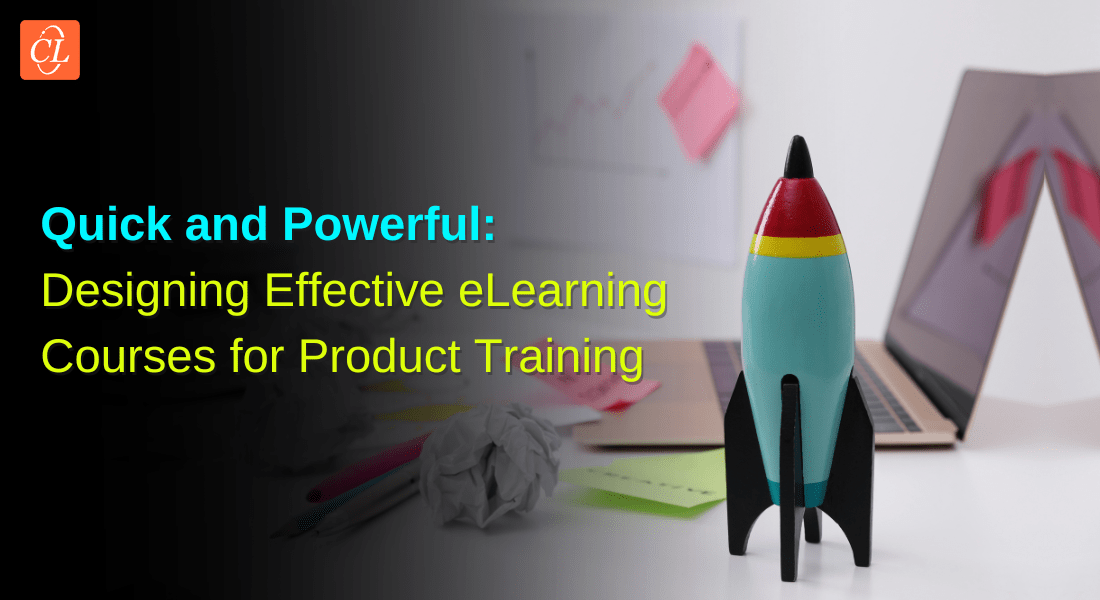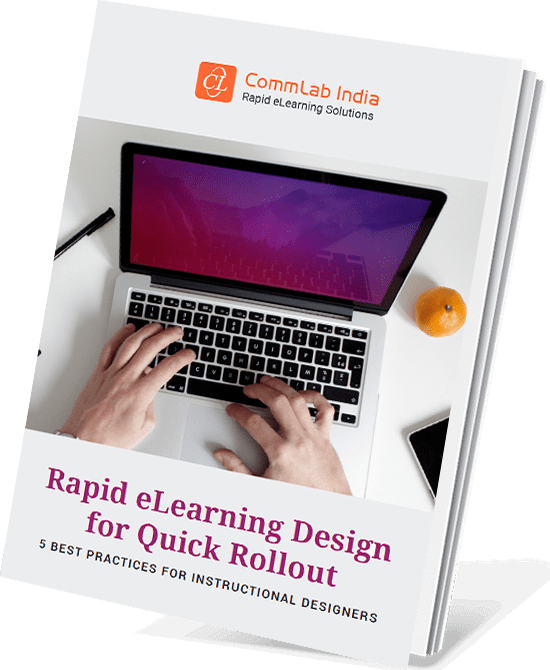How to Design Effective Rapid eLearning Courses for Product Training?

Are you struggling to keep your sales team up-to-date with the latest product updates and features? Do you worry because your company’s success depends on your sales team’s ability to effectively promote and sell your products? If the answer is yes, and you did think of providing them with the required corporate training but held back due to time constraints, then read carefully (and also happily). Because we have a solution for you! That’s right. It’s rapid eLearning.
Design Effective Rapid eLearning Courses for Product Training Now!
Here’s how:
- Identify your training objectives
- Use multimedia elements
- Keep it simple
- Use pre-built templates
- Incorporate assessments
Rapid eLearning? What is that you might ask. Well, let’s find out!
What is Rapid eLearning?
Rapid eLearning is an approach to training that emphasizes speed and efficiency. It involves using eLearning tools and instructional design strategies that help design and deliver training content quickly and effectively. Applying the idea of rapid eLearning specifically to product training, you can provide your sales and marketing teams with the knowledge they need to promote and sell your products in a fraction of the time it would take with traditional training methods.
Rapid eLearning and Product Training
I understand that in product training, it’s essential to keep up with the latest product information and features, and that’s where rapid eLearning comes in. With its interactive and effective approach, rapid eLearning can provide your sales and marketing teams with the knowledge and skills they need to promote and sell your products successfully.
→ Free Guide: A Training Manager’s Handbook to Rapid eLearning Development
It’s time to say goodbye to time-consuming and costly training methods, and hello to a more engaging and efficient way of learning. With rapid eLearning, you can provide your team with the latest product updates and features in a clear and concise manner, ensuring that they have the information they need to perform their job effectively.
So, let’s dive into how rapid eLearning can transform your product training game and ultimately drive your company’s success.
How to Design Effective Rapid eLearning Courses for Product Training
Identify the Training Objectives
In product training, identifying clear training objectives is crucial to the success of your rapid eLearning course. You must be clear with what your sales and marketing teams are expected to learn and what skills and knowledge they need to acquire to effectively promote and sell your products.
And to identify your training objectives, you should consider the specifics that your teams will be focusing on. What are the key features or benefits of each product? What are the common challenges that customers face and how can your products solve these challenges? Such questions help you design your course content in a manner that ensures your learners are receiving the right information.
Moreover, don’t forget to consider the different roles and responsibilities of your sales and marketing teams while designing product training courses. What specific skills or knowledge do they need to excel in their roles? For example, your marketing team may need to understand how to create effective product messaging and campaigns, while your sales team may need to know how to handle objections and close deals.
With your training objectives in place, you can easily tailor the course content to meet the specific needs of your sales and marketing teams which helps you ensure successful corporate training. Along with that you can measure the effectiveness of your training and make adjustments as needed to ensure that your teams are meeting their objectives.

Rapid eLearning Design for Quick Rollout
5 Best Practices for Instructional Designers
- Working Efficiently with SMEs
- Engaging Learners through Design Strategies
- Working with the Right Authoring Tools
- And More!
Use Multimedia Elements
Incorporating multimedia elements in your rapid eLearning course for product training can be especially beneficial. Understanding product features and specifications can often be complex, making it challenging for learners to retain the information when required.
But you can handle this problem by leveraging multimedia elements such as images, videos, and audio in your product training courses. They help you break down complex concepts into more manageable and understandable pieces. For example, you can use videos to demonstrate how a product works, showcasing its features and benefits in a more engaging and interactive way.
You can also use images to illustrate specific product components, making it easier for learners to visualize and understand how they work together. Furthermore, incorporating audio elements such as voiceovers or sound effects can help reinforce key concepts and keep learners engaged throughout the course.
Keep eLearning Courses Simple
As Walt Whitman once said, “The art of art, the glory of expression and the sunshine of the light of letters, is simplicity.” Similarly, it’s important to keep your rapid eLearning course simple and focused on the key information that your sales and marketing teams need to promote and sell the products.
Providing too much information, using complicated language and graphics, etc., can overwhelm your learners and distract them from the main message. Instead, you should focus on providing concise, relevant information, and use simple, clear language and visuals that boost information retention.
Well, you see how simple this is?
Use Pre-built Templates
When it comes to product training, time is of the essence. Isn’t it? Sales and marketing teams need to quickly learn about new products, their features, benefits, etc., to pitch them to customers. To ensure this, you need something that is captivating as well as time-saving. And what better than using pre-built templates in rapid eLearning?
Ready-to-use templates help you save time by providing a framework for your course design. Instead of starting from scratch, you can choose from various pre-built templates specifically designed for product training. Along with the time-saving element, it also ensures consistency in your course design, which is important for maintaining your brand’s image and messaging.
You can customize the templates to fit your specific product and company needs, while still maintaining a consistent look and feel throughout the course.
Incorporate Assessments
Assessments are a crucial component of any training course. They help you measure the effectiveness of your training program and identify areas where your learners may need additional support. After all, it is essential to ensure that your sales and marketing teams are effectively learning and retaining information about your products. Therefore, you should incorporate assessments into your product training rapid eLearning courses.
It can either be a formative assessment or a summative assessment. Formative assessment is an ongoing process of evaluating the learners during the course. Whereas summative assessment is conducted at the end of the training to check what the learners have acquired from the complete training. There are different ways to conduct the assessment.
One effective and common example of assessment for product training is quizzes. You can use them to test learners’ knowledge of product features, specifications, and benefits. Creating quizzes in rapid eLearning is pretty easy. Pick your favorite eLearning authoring tool and design a quiz that is tailored according to your training content and focuses on areas where learners might need attention.
Another useful one is simulations. These simulations can be used to test learners’ skills in applying product knowledge to real-life scenarios. By placing learners in simulated situations where they need to use their product knowledge to make decisions or solve problems, you can better assess their understanding of your products and their ability to sell them effectively.
Wrapping It Up!
Leveraging rapid eLearning for product training is a fantastic way to quickly train your sales and marketing teams. By implementing the tips outlined above, you can easily design and develop engaging eLearning courses that will help your learners acquire new skills and knowledge in the best way possible. So, go ahead, get creative, and start designing your product training courses with rapid eLearning today! Check out this handy guide on rapid eLearning design for quick rollout.





